Mario Bava’s Gorgeous Observance Of The Night
DIRECTED BY MARIO BAVA/1964
STREET DATE: OCTOBER 24TH, 2023/KL STUDIO CLASSICS
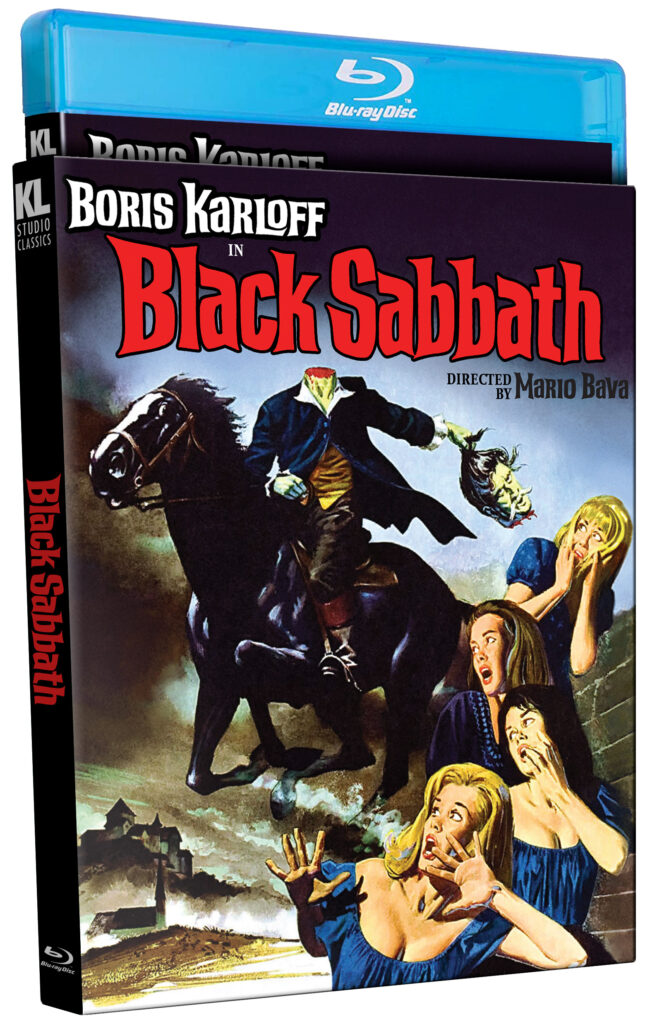
Up front, Kino Lorber Studio Classics’ updated Blu-ray of Mario Bava’s 1964 anthology film is a slip-covered and deluxe-packaged reissue of the English-language version originally prepared by American international Pictures, who as co-producers of the internationally-financed Italian film I tre volti della paura, or The Three Faces of Fear, re-titled it Black Sabbath. Shifting the order of the three original title-segments, and in some cases altering their content, the ‘AIP cut’, if you will, for all its needless story-dilution and unnecessary character-changes has one element the otherwise superior Italian-language film lacks: the voice of Boris Karloff. Possibly the horror legend’s finest moment on film, Karloff onscreen presents the first two segments before black-cloak, curly white-haired, snow bushy-mustachioed, red-rimmed eyes, and chalk-yellow visage embodying the final segment as its title Wurdalak. A fearsome creature of the dark sprung from the deepest recesses of Eastern European folklore, the Old World horror of this singularly unnatural paterfamilias is undoubtedly best conveyed through the minor-key mellifluous vocal tones of the unmistakable and uncanny Karloff himself.
Returning to the possibly labored header “Mario Bava’s Gorgeous Observance Of The Night” above, what I hoped/hope to get at in this rephrasing of AIP’s re-title, with ‘observance’ referring to both ‘seeing’ and unholy religious ceremony, while ‘night’ in context may bring to mind its color, or lighter-spectrum lack thereof, is an entirely unintentional, seemingly unrelated, commercially-driven impulse – a “black sabbath” as such appearing nowhere in any of the films three segments – that nevertheless ends up perfectly evoking a dread supernatural feel/fear that pervades the entire film. A horror film of unusual beauty in whatever version you happen to view it, Mario Bava’s breathtaking color images and gorgeous widescreen compositions give pictorial voice to a vision of the dark that finds its perfect audio echo in the soft growl and deeper vocal-shades of an undead being risen from the night. A brief look – written only, unfortunately, but if you’re looking for a voice to read it in may I suggest Karloff’s own? – at how that audio-visual dialectic pairs in the English-language version of Black Sabbath, following in the specific order that AIP rearranged them:
“The Drop of Water”
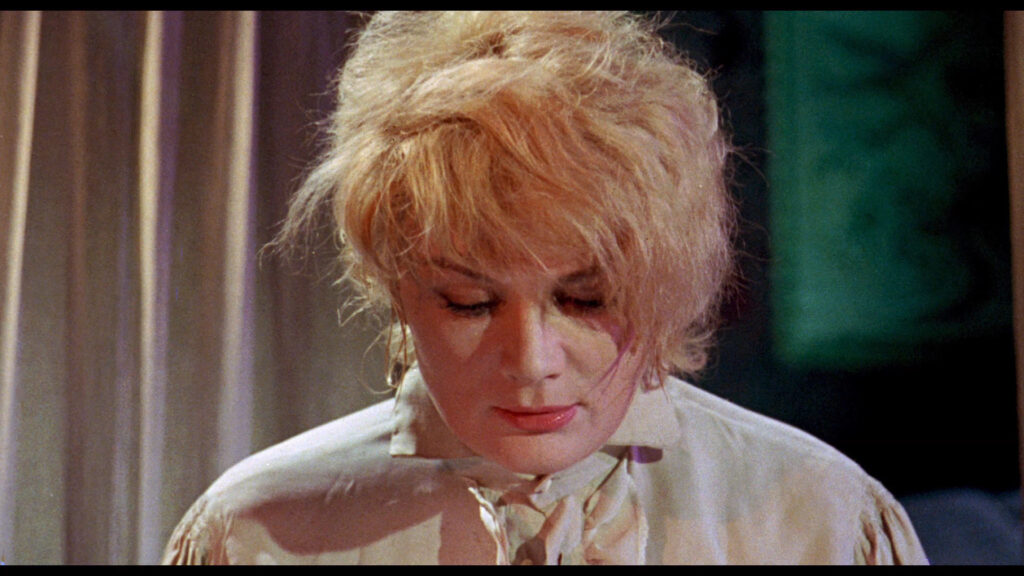
After an introduction in which Karloff sets the stage as it were for the “black sabbath” to follow, his disembodied head appearing to float against a black background, Karloff immediately returns at a lower angle against a cerulean background, with a pipe in his mouth and dressed in a casual tweed jacket, to introduce the first segment, whose title is visually punctuated by the shimmering drops rippling over the watery frame. Set in the late 1800s/early 1900s, one Helen Chester (Jacqueline Pirreux; French actress and mother of Jean-Pierre Léaud, for some reason credited by AIP as “Soussard”) leads a shabby Bohemian life of scratchy gramophone ambience, empty wine bottles, and rumpled bathrobe self-pity disrupted suddenly by a call – significantly for the next sequence, on an early telephone – to the house of a medium who has died suddenly in the night. While preparing the body for burial, the face of the corpse wide-eyed twisted into a grotesque expression suggesting extreme shock, the medium’s dowdy housemaid (Italian cabaret star ‘Milly’) leaves Chester to notice an unusually persistent fly landing on the uneasily resting hand of the emphatically dead mistress of the incredibly spacious yet somehow still over-cluttered house. Shooing the buzzing fly away repeatedly, it nevertheless returns to the yellowed hand each time, drawing Chester’s attention to a beautiful ring on the medium’s dead finger. Set now to the mysterious and eerie soundtrack of the drop of water, whose source is never wholly explained, the apparent consequences of the ring’s theft follows Chester back to her own considerably cluttered but far less spacious apartment, where subsequent post-mortem encounters with the dead medium proceed Helen Chester’s own horrifying death-expression. But not before a neighbor (Helen Medin) has noticed the beautiful ring on the fresh corpse’s twisted finger, and has unwittingly transferred it to her own…
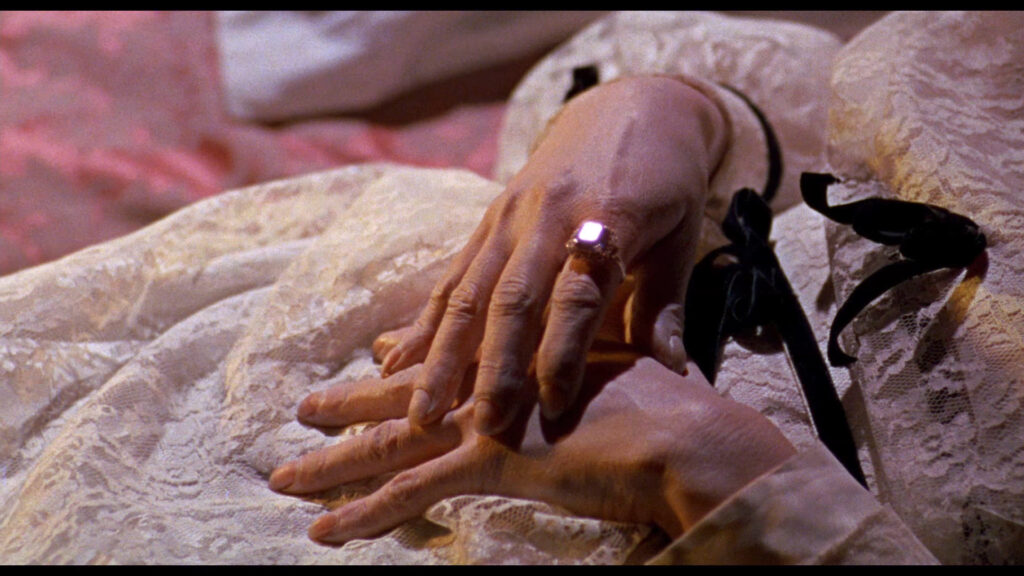
Drawing viewers in with sly atmospheric touches including but not at all limited to a green neon-sign flashing outside Chester’s window through the darker ends of the evening, the disordered and discarded interior bric-a-brac redolent of messy lifestyles after-hours, and an acute psychological attention in the audio-mixing to sounds that go bump in the night, the visual and audio equivalents to a persistently maddening dripping faucet or a peace-invading leaky roof lead inexorably to the more supernatural passages alluded to above. Building on the unlikely horror of the mundane and the usual, the everyday and ordinary gradually gives way to the unusual, extraordinary, and indeed uncanny. Playing out in near silence from beginning to end, and over in a mere 20 or so minutes (the shortest running time of the three segments), the “near” qualifies a whole sonic world in A Drop of Water that is in fact quite far from actually silent. The near-absence of dialogue imbues the visuals themselves with suspense, the camera moving through increasingly subjective lights, colors, and shadows cast over transformed interiors, the tables, lamps, and (especially) chairs that now seem far from comforting or familiar, as the mounting cacophony of buzzings, clanks, clangs, and (especially) echoes resound with a sinister new audio dimension. And it all begins with one *drop*.
“The Telephone”

That new audio dimension is taken up visually with Karloff’s introduction of The Telephone with a split-screen, forced-perspective shot of a monstrous hand picking up a giant receiver from its deaf-ringing cradle, presaging the terror to follow surrounding that modern miracle of instant communication, the telephone itself. Panning over the tasteful, feminine, and stylish furnishings of a luxurious mid-century apartment, its equally beautiful inhabitant (Michele Mercier) strolls in after an evening on the town to the after-dark comfort of a few drinks and a bath before bed. That sense of comfort is soon disrupted by the insistent ringing of the title instrument, whose answered, over-familiar tone, building to threats of direct bodily harm, is disturbingly signaled by the camera panning sensuously down Rosy’s curvaceous form. Someone, somehow is watching, the voice at the other end a disembodied yet somehow present and unwelcome violation of her safety and privacy, but who, how? Calling her friend Mary (Lidia Alfonsi), whose glacial expression and languid body language suggests an uneasy agenda of her own, Rosy and Mary together while away the night in a waiting and uncertain dawn, the suspense over who has reached out and touched our fair mistress of the evening, and how, soon answered by the quick approach of those terrible promises soon to be kept at the other end. A connection somehow physically present in Rosy’s own room…
This was the segment AIP altered the most, first to remove or soften the implication of Rosy’s sex-work, along with a deeper implication of a past lesbian relationship between Rosy and Mary, and second to graft on an ill-fitting supernatural or ghost-like explanation to the unknown caller. Both changes are ludicrous in the context of the story, which mines “real” horror in a modern setting, but psychologically and stylistically, the levels on which Bava intends the segment to operate anyway, the white-knuckle suspense remains palpable throughout. Indeed, the gloved hand, peering eyes, and disguised, disconnected voice would become increasingly familiar in Italian cinema from Bava’s subsequent production of Blood and Black Lace (1964), also scripted by the segment’s presumed author Marcello Fondato. And through The Telephone‘s strobing lights, roving, searching camera, tight close-ups, and most of all full-spectrum color-scheme – the black phone, yellow foreground, and deeper red background – all seem to give birth to a new genre even as we view it. The sounds themselves no less subjective than the previous segment, the peculiar resonance of the sexless voice on the other end especially terrifying, we can somehow guess from the first pan across the still, unnaturally silent space that this isn’t going to end well, as the audio-visual connection between one end of the telephone and the other becomes “complete”.
“The Wurdalak”
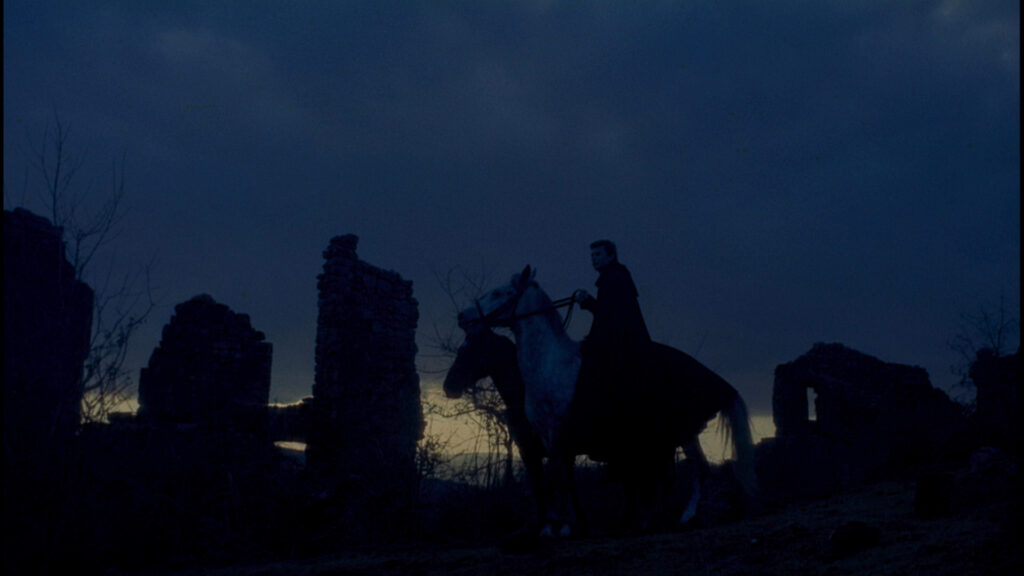
Appearing even more sedate and deceptively mellow in his introduction to the segment in which he takes the central part, Karloff’s eventual appearance about 10 or so minutes into the longest of the three segments plunges us into the folklore nightmare world of ancient superstitions, and the perversion of human nature itself. An aristocrat (Mark Damon) traveling from court through the wilds of Eastern Europe comes on a lonely mountain pass where he finds a headless body with a knife in its chest. Upon being led to a nearby homestead, inhabited by an extended family of backwoods people, he learns the desecrated corpse was formerly a bandit likely murdered and beheaded by the absent father-chief of the estate. Gorca (Karloff) returns later that evening to a stunned reaction from his sons and daughters, including Pietro (Massimo Right), Giorgio (Glauco Onorato), Maria (Rika Dialing), and Sdenka (Susy Anderson), the latter blonde maiden having quickly aroused the interest of the aristocrat Vladimire. From his unkempt appearance, lumbering gait, blood-soaked clothing, and soft-snarling, surly manner, Gorca attracts suspicion almost immediately, spurning an offered dinner of a lamb-roast with the same ferocity that he pulls the bandit’s head from his riding-satchel, and is soon skulking around his now unfamiliar grounds like a predatory animal, ordering a dog to be shot, spying through windows, and eventually kidnapping and riding off with his own grandson.
The last act inspires unsuccessful pursuit from the members of his family, who one-by-one fall prey to the unholy curse of the Wurdalak, the circle of bloodthirst, predation, and vampirism extending to a newly-constituted family of night-monsters.
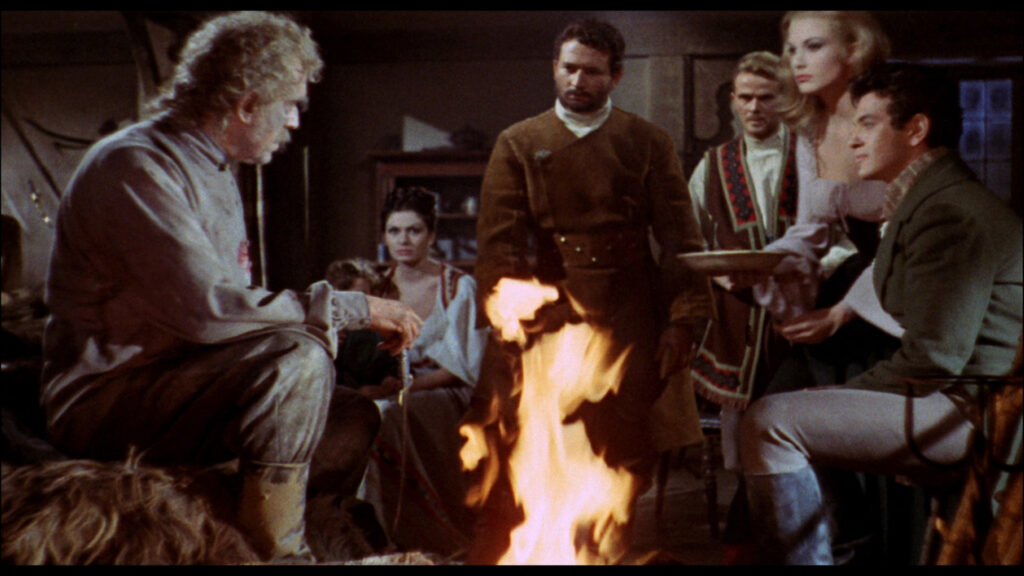
Children of the night! While not exactly making music as such, Bava’s family of eventual vampires – “wurdalak” in the dialect of this remote region – do seem to communicate by an unheard telepathic connection undoubtedly exceeding the terror of a nightly visitation from a corpse (or even the answering of a threatening phone call). Especially effective in the sequence is the unearthly atmosphere surrounding the castle ruins where the family of wurdalak gather, a spiritual cemetery of strange twilight effects (created by glass-mattes, background painting, colored gels, and zoetropic light-strobing) where the dead don’t necessarily die, but whose unnatural extension of life, fully unlived, precedes a literal and vividly-realized eternal night. As described in the introduction, the totality of Karloff’s “presence” in the title-role may lay claim to being among the most effective screen translations of the vampire legend to the screen, and despite the changes AIP brought to bear on many aspects of the film, should again be heard with Karloff’s own voice evoking the darker corners of that night. What music he makes!
…
Using rival Lugosi’s words to bookend a brief analysis of Karloff’s possibly finest moment on film above may not be wholly appropriate, but as audio commentator Tim Lucas observes, in his (I believe) 2013-recorded commentary, revived for KLSC’s updated Blu-ray – rising from the dead ashes of a previous home video release, as it were – The Wurdalak represents the closest, and certainly most accomplished, approximation of a Karloff-starring Dracula. That intriguing tidbit is but the tip of the iceberg, or but one lighter shade of the night, paraphrasing Lucas’s subtitle of his definitive 2007 Mario Bava critical biography All the Colors of the Dark (which in its limited edition commands prices of literally thousands of dollars at this time of writing on the internet), with his feature-length analysis combining in-depth research, considerable expertise, convincing scholarship, and a warm, witty, and inviting tone. It is, in short, everything a commentary can and should be, as we have come to expect nothing less from Mr. Lucas, and in addition to Mr. Karloff’s own voice makes this presentation of the English-language Black Sabbath a must-own for the most discerning, or maybe just more than moderately obsessive, fan.
Appearing to be the restoration used on previous DVD and Blu-ray releases of the past decade, the transfer of which reputedly offered considerable difficulties and varying issues, this reissue has the advantage of higher resolution, which looked and sounded fine when I first played this disc for the film, and second when I played it for the commentary. Also appropriate for this release is the art double-used for both the outer slipcover and inner case; which (again, I believe) was the original poster art commissioned by AIP for the film’s abbreviated US-theatrical run; which as Lucas tells us opened in New York on a double-bill with the 1964 feature-film of TV’s McHale’s Navy. That poster image, the beheaded bandit from The Wurdalak, presumably, wielding his own head headless horseman-style on horseback, while a quartet of Hammer-like ingenues in low-cut, dark-blue blouses look on in terror, has almost nothing to do with Mario Bava’s film, but is probably the perfect choice to advertise and contextualize a version of the film that somehow survived the disrespect of its American distributors and co-financiers, and nevertheless remained and remains through its many challenges of exhibition, distribution, and preservation a chilling evocation of the past, present, and even future of horror. In the end, perhaps that is the ultimate testament to both Karloff’s voice and Bava’s vision.
Images used in this review are used only as a visual reference to the film, and do not represent the image-quality or content of Kino Lorber’s Blu-ray release.

